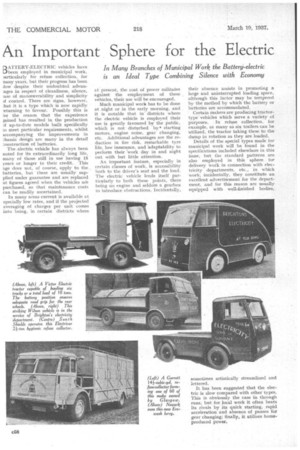An Important Sphere for the Electric
Page 108

If you've noticed an error in this article please click here to report it so we can fix it.
In Many Branches of Municipal Work the Battery-electric is an Ideal Type Combining Silence with Economy
DATTERY-ELECTRIC vehicles have Li been employed in municipal work, iarticularly for refuse collection, for nany years, but their progress has been low despite their undoubted advan:ages in respect of cleanliness, silence, ase of rnanceuvrability and simplicity A control. There are signs, however, :hat it is a type which is now rapidly returning to favour. Possibly this is or the reason that the experience pined has resulted in the production A up-to:date models built specifically to meet particular requirements, whilst tccompanying the improvements in tlassis design are many in the detail :oustruction of batteries.
The electric vehicle has always been noted for its extraordinarily long life, many of those still in use having 15 years or longer to their credit. This age does not, of course, apply to the batteries, but these are usually supplied under guarantee and are replaced at figures agreed when the vehicles are purchased, so that maintenance costs can be readily ascertained.
Iii many areas current is available at specially low rates, and if the projected averaging of charges per unit comes into being, in certain districts where at present, the cost of power militates against the employment of these vehicles, their use will be encouraged.
Much municipal work has to be done at night or in the early morning, and it is notable that in districts where the electric vehicle is employed their use is greatly favoured by the Public, which is not disturbed by • starting motors, engine noise, gear changing, etc. Additional advantages are the reduction in fire risk, remarkable tyre life, low insurance, and adaptability to perform their 'work day in and night out with but little attention.
An important feature, especially in certain classes of work, is accessibility both to the driver's seat and the load. The electric vehicle lends itself particularly to both these points, there being no engine and seldom a gearbox to introduce obstructions. Incidentally, their absence assists in promoting a large and uninterrupted loading space, although this factor may be tempered by the method by which the battery or batteries are accommodated.
Certain makers are producing tractortype" vehicles which serve a variety of purposes. In refuse collection, for example, as many as six trailers can be utilized, the tractor taking these to the dump in rotation as they are loaded.
Details of the special types made for municipal work will be found in the specifications included elsewhere in this issue, but the standard patterns are also employed in this sphere for delivery work in connection with electricity departments, etc., in which work, incidentally, they constitute an excellent advertisement for the department, and for this reason are usually equipped with well-finished bodies, sometimes artistically streamlined and lettered.
It has been suggested that the electric is slow compared with other types. This is obviously the case in through runs, but for local work it often beats its rivals by its quick starting, rapid acceleration and absence of pauses for gear changing; finally, it utilizes homeproduced power.
























































































































































